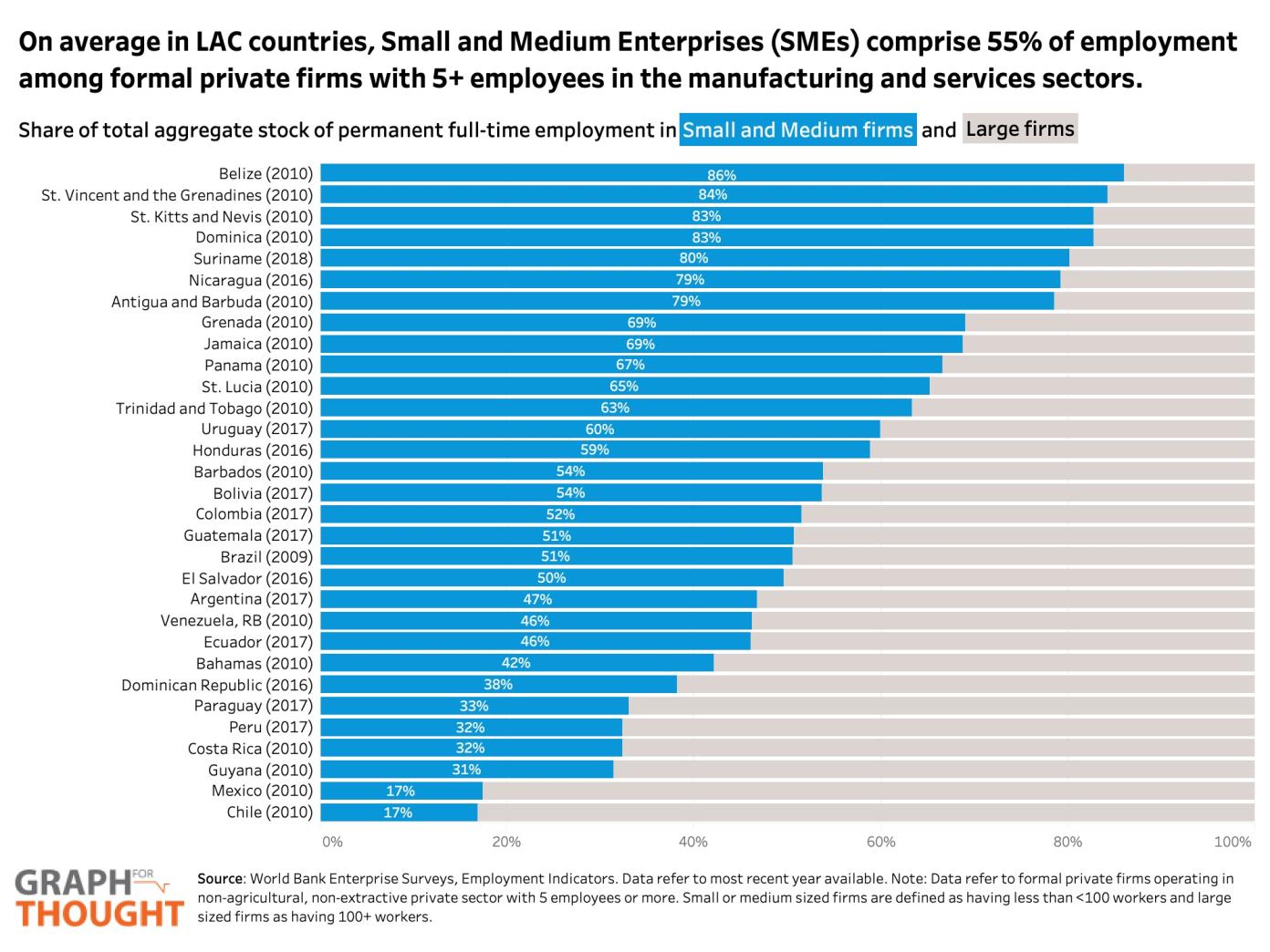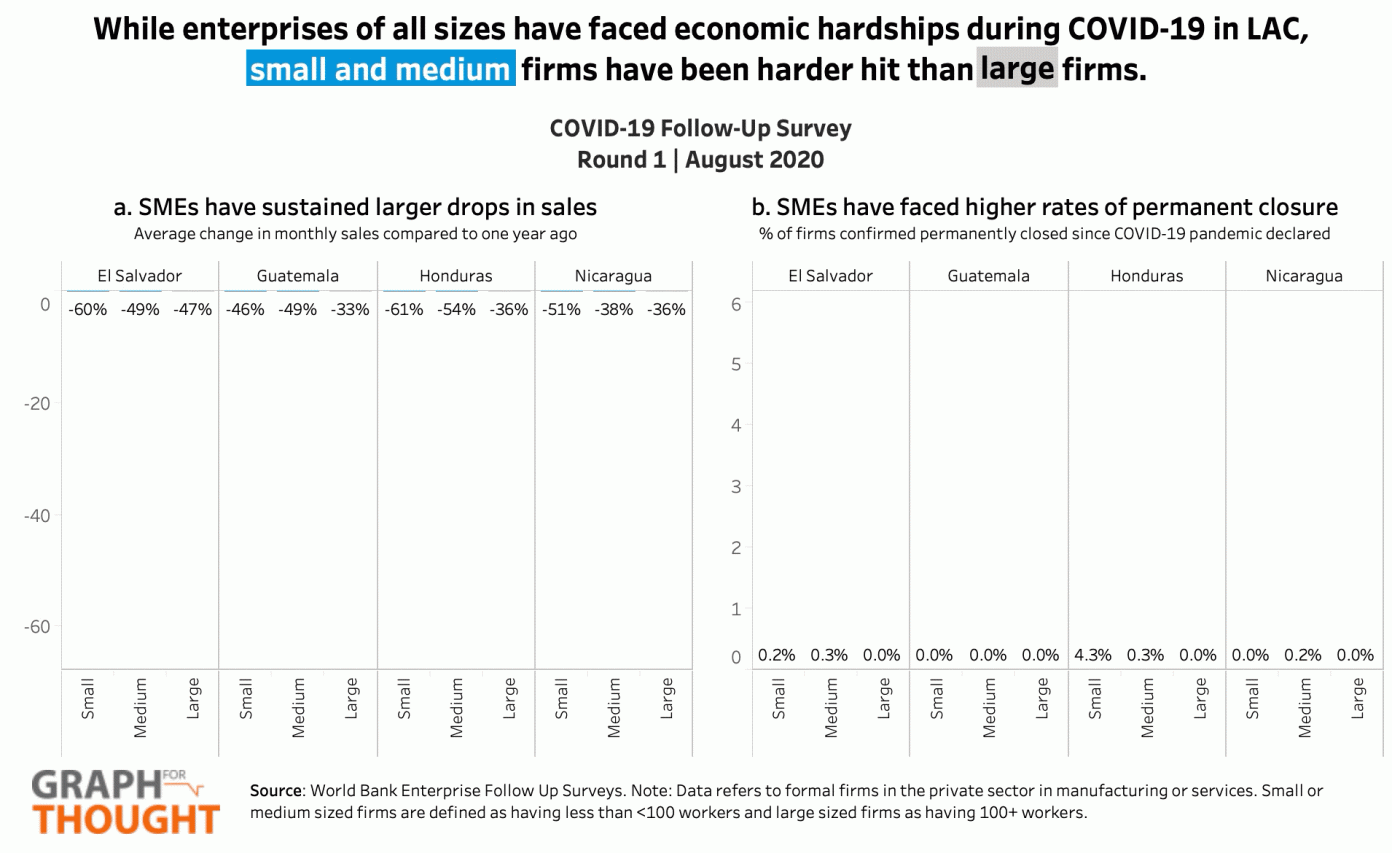Small businesses, big impacts: Supporting productive SMEs as an engine of recovery in LAC
April 21, 2021
Many businesses across the world shut their doors for prolonged periods of time this past year, as societies entered COVID-19 lockdowns and people were encouraged to stay at home. Some of those businesses will not reopen. Where businesses were unable to cover accumulating costs in the face of falling sales, they were pushed beyond their survival thresholds. Notably, not all firms have been affected by COVID-19 equally. Of course, which sector the firm is in matters very much—for example, in the Caribbean the tourism sector has been hit particularly hard by COVID-19. Beyond the firm’s sector, however, its size matters too. Often larger firms may have a greater ability to weather a shock like COVID-19, for instance if their size enabled them to build a larger stock of cash reserves, gain easier access to finance, invest in teleworking infrastructure, adapt to providing home delivery services, or diversify their business across multiple locations.
This #GraphForThought focuses on how the pandemic has impacted Small and Medium Enterprises (SMEs) in Latin America and the Caribbean (LAC). In LAC, as in many middle-income and low-income countries, SMEs are a primary source of employment and key supplier of goods and services to a large share of the population. Estimates suggest that SMEs comprise as much as 99.5% of all businesses in the region, 60% of the employed population, and 25% of GDP.
In order to understand the impacts of the pandemic on SMEs, this post uses data from the World Bank’s Enterprise Surveys – as they conducted follow-up surveys with businesses during the pandemic. Unfortunately, this database only includes a subsection of SMEs in the region - those that are registered in the manufacturing or services sectors with 5 employees or more. As informal employment and self-employment in micro-enterprises are widespread in the region, it is important to remember that the survey data used here only tell one part of the story.
Based on this data, we see that on average, these subgroup of SMEs (defined as enterprises with fewer than 100 workers, and shown in light blue on the graph) comprise 55% of formal employment in the private sector in LAC countries. In some countries, this share reaches over 80%—with the highest shares found in Belize, St. Vincent and the Grenadines, St Kitts and Nevis, and Dominica. On the other end of the spectrum, these subgroup of SMEs comprise just 17% of formal employment in the private sector in Mexico and Chile.

How have these businesses fared in the wake of the pandemic in comparison to large firms? While data is scarce and imperfect, the Enterprise Surveys team conducted COVID-19 “follow-up” surveys for four countries in the region (El Salvador, Guatemala, Honduras, and Nicaragua) which help offer a better understanding of how things are changing. Two rounds of the follow-up survey data were collected, with the first round collected in August 2020 and the second round collected in January 2021.
As the graph illustrates—at the aggregate level, firms of all sizes have been negatively affected by the pandemic in all countries. However, SMEs (shown in light blue)—and in particular, small enterprises—have seen larger sustained drops in sales as well as faced higher rates of permanent closures than large firms. As of the first survey round, small enterprises in El Salvador and Honduras saw drops in sales of as much as 60%. Between the first and second survey rounds, however, sales were beginning to recover for firms of all sizes in all countries (though, they still remained far below pre-pandemic levels). In terms of permanent closures, while very few firms of any size had closed as of the first round of data collection—by the second round, many more firms had shuttered, with worse outcomes for SMEs. As of January 2021, as many as 5.5% of small firms in Honduras had permanently closed and 3.5% of medium firms in Nicaragua had permanently closed.

Of course, this type of survey data is limited in what it can tell us—both given limited coverage of countries in the region and limited coverage of different types of firms (excluding, for example, informal firms as previously discussed). However, other sources of data that are able to capture more information point to a similar directional impact of COVID-19 on SMEs in LAC—and suggest that the size of impact may potentially be much larger than shown in the Enterprise Survey data here. For example, based on recent data from Mexico, INEGI reported that a staggering 20.8% of micro, small, and medium enterprises (MSMEs) closed permanently between May 2019 and September 2020 (approximately 1 million firms).
Support to struggling businesses (and their workers) has been a central part of governments’ economic relief strategies throughout the pandemic. These measures have taken a wide range of forms—including deferring payments, facilitating access to credit, and offering grants or subsidies. However, up against the reality of a constrained fiscal space, many LAC countries have faced challenges in providing adequate support to SMEs. As a critical source of employment and a lifeline of economic prosperity for so many communities across the region, it is essential that we work to support SMEs on the path to recovery. This requires investments in both resilience and productivity. On the one hand, the pandemic has shown the fundamental importance of strengthening the resilience of individual SMEs to shocks. On the other hand, it has also provided an opportunity reflect on the lost productive potential of SMEs. SMEs in LAC face chronically low levels of productivity—with SMEs in LAC generating just half the amount of wealth that SMEs do in Europe. If countries were to act now to address some of the structural barriers that SMEs face, such as access to finance, investments in digitalization and innovation, regulatory burdens, or broader challenges in the enabling environment—SME growth could become a strong engine of sustained economic recovery in the region.

 Locations
Locations